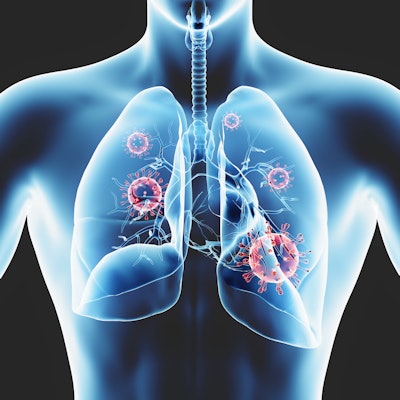
Patients who die from COVID-19 tend to have different findings on CT compared with those who survive the disease, according to a study published July 9 in Nature: Scientific Reports.
The study results could help clinicians better understand COVID-19 patients' prognoses, wrote a group led by Dr. Feng Pan of Huazhong University of Science and Technology in Wuhan, China.
"[Patients who died from COVID-19] demonstrated more rapid and persistent progression with more extensive bilateral lesions until [acute respiratory distress syndrome] occurred," the group wrote.
Previous research has linked severe and critical COVID-19 to particular findings on CT, including diffuse lung involvement, acute respiratory distress syndrome (ARDS), and multiorgan failure. Pan and colleagues sought to identify CT features that could shed light on patients' prognoses. For their study, the team analyzed records of 124 patients with COVID-19 (median age, 56), categorizing them into those who survived (83) and those who did not (41) and then comparing chest CT findings between the two groups.
The researchers found that those patients who died were older, with a median age of 69, and more likely to have comorbidities such as hypertension, diabetes, and coronary heart disease; they also tended to have higher C-reactive protein (78.11 mg/L compared with 10.85 mg/L) and D-dimer (1.98 mg/L compared with 0.30 mg/L) values. The researchers also found particular CT patterns between the two groups:
| CT patterns among COVID-19 survivors and nonsurvivors | ||
| Finding | Survivors | Nonsurvivors |
| Bilateral lesions | 73.5% | 97.6% |
| Diffuse lesions | 8.4% | 39% |
| Total CT severity score (median) | 4 | 10 |
| Crazy-paving pattern | 12% | 39% |
Those patients who survived COVID-19 experienced increased CT severity scores within the first 20 days of hospital admission that peaked at six points and then decreased; scores in patients who died quickly increased to more than 10 points in the first 10 days of admission and continued to do so until patients experienced ARDS.
"Initial symptoms were similar between survivor and nonsurvivor groups, while chest distress was more common in the nonsurvivor group," the investigators wrote.
Fan's team hopes that this research will help their colleagues better assess the severity of COVID-19 patients' disease.
"In summary, from comparisons between survivors and nonsurvivors, this study indicated that the presence of predominant crazy-paving pattern on chest CT with the high and rapidly increased CT scores may help to identify the patients at high risk of developing ARDS before clinical deterioration," the group concluded. "A larger, prospective study is required to confirm these findings with the more accurate quantitative assessment modality of the CT images in COVID-19."




















